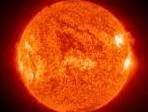
"This sunspot is like the first robin of spring," said solar physicist Douglas Biesecker of NOAA's Space Weather Prediction Center.
"In this case, it is an early omen of solar storms that will gradually increase over the next few years."
A sunspot is an area of highly organised magnetic activity on the surface of the Sun. The new 11-year cycle, called Solar Cycle 24, is expected to build gradually to reach a maximum by 2011 or 2012.
However, the NOAA scientists warned that "devastating" storms could occur at any time.
During a solar storm, highly charged material ejected from the Sun may head towards Earth, where it can bring down power grids, disrupt critical communications and threaten astronauts with harmful radiation.
Storms can also knock out commercial communications satellites and swamp GPS signals.
"Our growing dependence on sophisticated space-based technologies makes us far more vulnerable to space weather than in the past," said Vice Admiral Conrad C. Lautenbacher Jr, under secretary of commerce for oceans and atmosphere at NOAA.
NOAA issued a forecast in April 2007 in conjunction with an international panel of solar experts suggesting that Solar Cycle 24 would start in March 2008, plus or minus six months.
The panel was evenly split between those predicting a strong or weak cycle. Both camps agreed that the sooner the new cycle takes over the previous cycle, the more likely it is that it will be a strong season with many sunspots and major storms.

_(22).jpg&h=140&w=231&c=1&s=0)






_(26).jpg&w=100&c=1&s=0)

 iTnews Executive Retreat - Security Leaders Edition
iTnews Executive Retreat - Security Leaders Edition












_(1).jpg&h=140&w=231&c=1&s=0)



